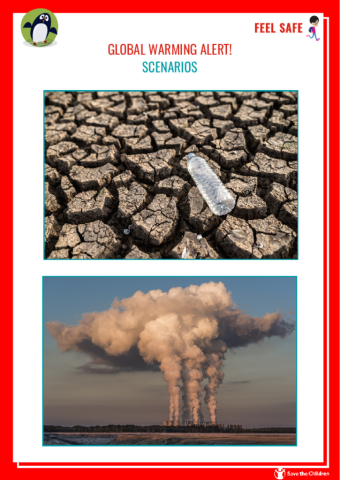Global warming alert!
Objectives:
- Understand the concept of global warming and its causes
- Analyse the role of human activity in climate change
- Develop teamwork and critical thinking skills
STEP BY STEP
Before starting
The teacher begins the activity by asking students what they know about global warming and the greenhouse effect. They can use the following stimulus questions to guide the discussion:
- What is climate change and why is there talk of a climate crisis?
- Is the greenhouse effect good or bad?
- Does air pollution have anything to do with climate change?
- What are the main human activities that release greenhouse gases into the atmosphere?
The teacher writes their answers or the key words that emerge on the blackboard, correcting any misconceptions on the topic and using this brainstorming moment to explain to the class that it is a gradual increase in the average temperature of the Earth's atmosphere, mainly caused by human activities.
Greenhouse effect
The teacher then presents the topic. He or she can help by reading the following description:
The greenhouse effect is a natural phenomenon that occurs when the sun's heat is captured by the Earth's atmosphere and reflected back to the ground. This phenomenon was used by plants to survive during the Ice Age, when the planet was colder.
Beginning in the 1950s, emissions of greenhouse gases such as methane and carbon dioxide increased dramatically due to the use of fossil fuels, deforestation and agricultural activities. These greenhouse gases have created a kind of 'film' around the Earth that prevents the planet's temperature from cooling.
But how does the greenhouse effect work? The sun emits solar rays to the Earth and most of these are absorbed by the Earth's surface. The absorbed heat is released back into the atmosphere.
Greenhouse gases, such as methane and carbon dioxide, absorb this heat and reflect it back to the earth's surface. The reflected heat increases the Earth's temperature, creating a greenhouse effect.
At this point, the teacher asks the class to suggest what might happen if we all do not act in time to reduce greenhouse gas emissions. After collecting a few answers, the teacher proceeds to present the most likely effects:
- Higher temperatures: increase in global temperature that could exceed 2°C compared to pre-industrial levels.
- Extreme weather events: an increase in extreme weather phenomena such as floods, droughts and hurricanes.
- Climate change: Alteration of the natural cycle of seasons and climatic conditions.
- Risks to biodiversity: threatened survival of animal and plant species.
To reduce these dangers, what can we do to fight climate change?
If governments and large corporations are called upon to make a decisive contribution to the battle against climate change, we must all realise that the behaviour of individual citizens can also contribute to the common good. Indeed, with a responsible attitude and civic sense, each of us can direct our daily actions towards the sustainability Development that ensures that the needs of the present generation are met without compromising the ability of future generations to meet their own needs of the planet.
The teacher shares a series of small examples of virtuous behaviour, then asks if others come to mind:
- in the city move around by bicycle and on foot, avoiding being accompanied by a car all the time, to reduce transport emissions;
- at home use hot water and air conditioning only when really necessary, to save energy and limit polluting emissions;
- apply the 3 Rs principle: reduce, reuse, recycle, to reduce consumption and the consequent production of waste;
- adopt a sustainable eating style: eat fruit and vegetables in season, to reduce unsustainable crops; buy local food, to reduce emissions due to the transport of products; reduce meat consumption, to limit atmospheric pollution caused by intensive farming.
The poster of Change
The teacher now asks the class to reflect on climate change in the light of what was explained in the first part of the activity through a 'creative' research.
After dividing the children into 5 groups, the teacher assigns each one or more different landscapes representative of climate change. The teacher can print out the "Scenarios" pictures (see attachment "Scenarios - Global Warming Alert!" below) or choose their own.
Using the materials provided by the teacher, independent research on the Internet, newspapers or textbooks, students should investigate their own scenario and find scientific information and data that explain the causes and effects of climate change on their scenario. Groups can also identify and share solutions or virtuous examples that already exist to limit negative impacts.
The result of this research should be reproduced in artistic form on a poster, which will be presented by each group to the whole class at the end of the activity.
Concluding thoughts
At the end of the sharing of all the research, the teacher can encourage a plenary reflection on the possibility of reversing course and becoming advocates of change for a better world.
In a circle, all children are asked what behaviour or action they intend to carry out at school or at home to pursue the cause and be an example to others in the fight against climate change.

Add new comment